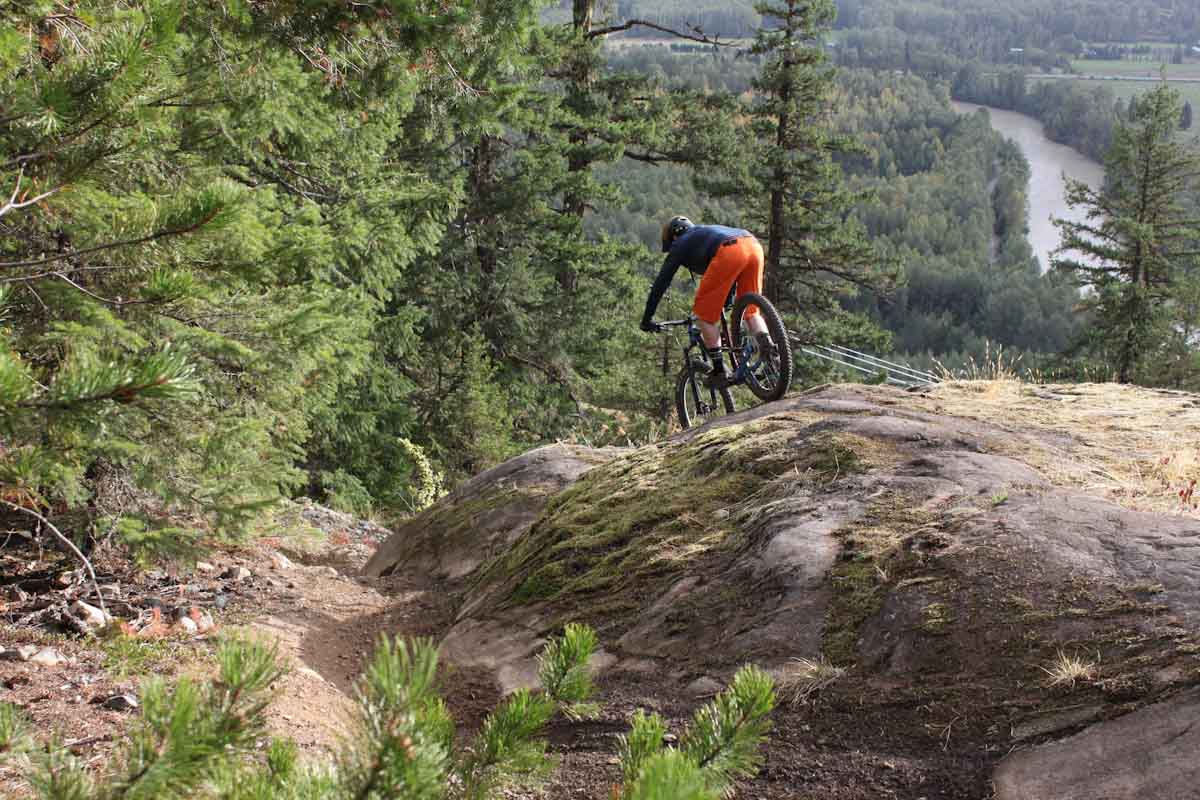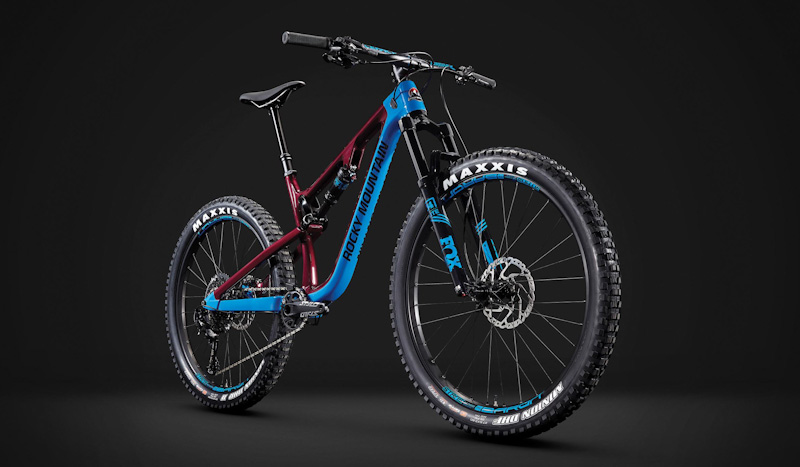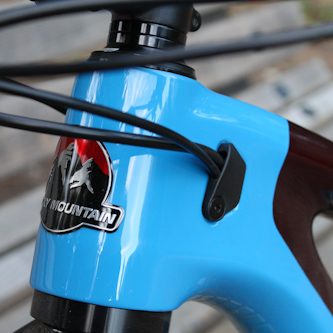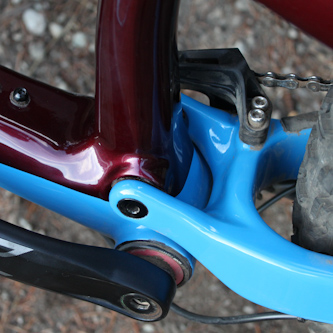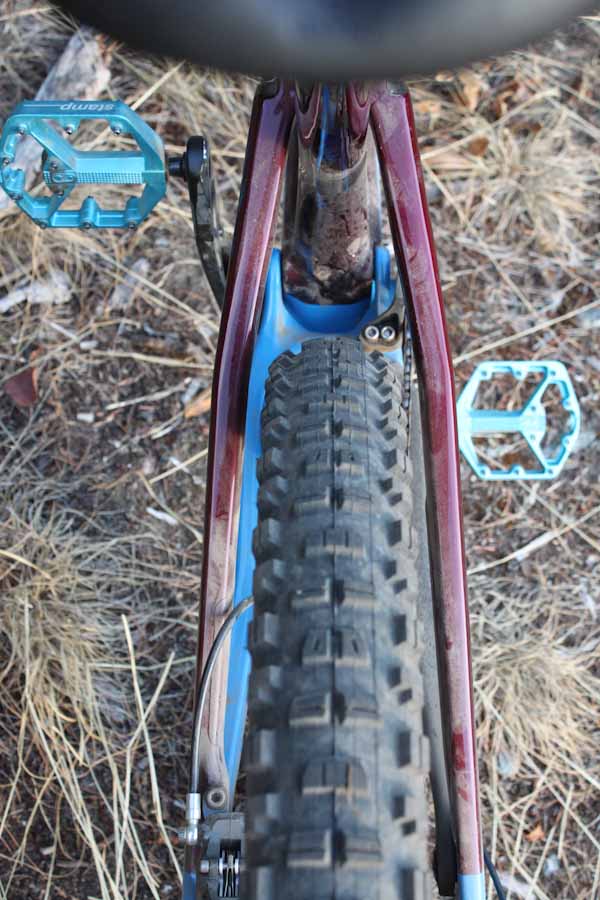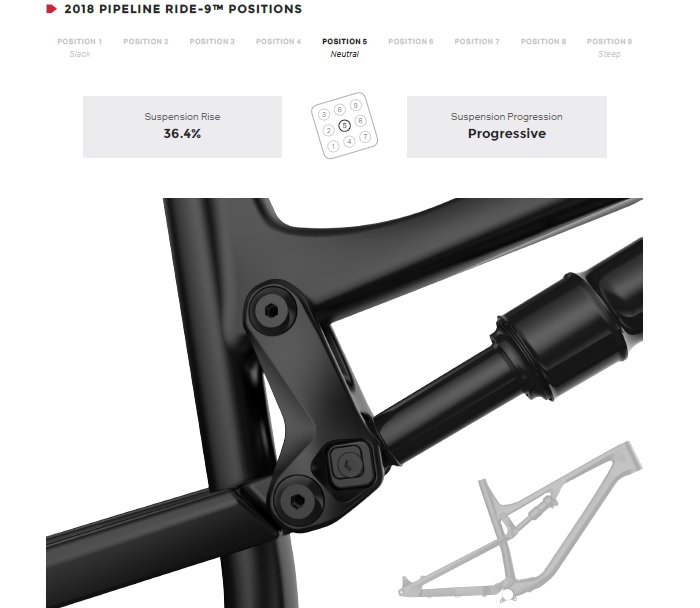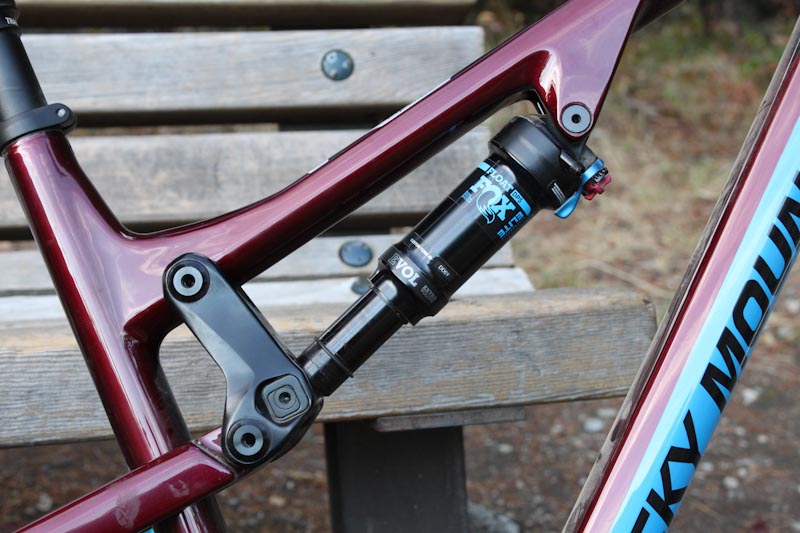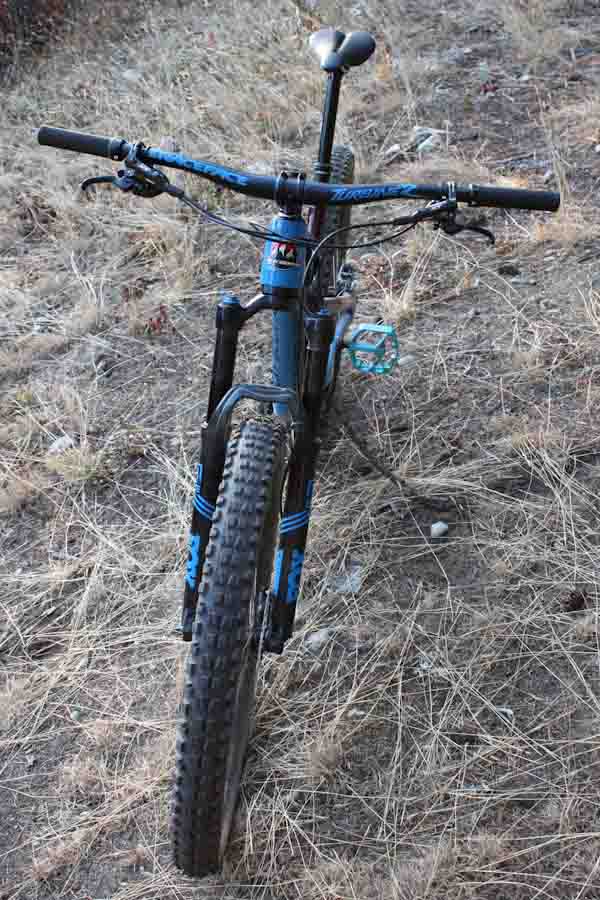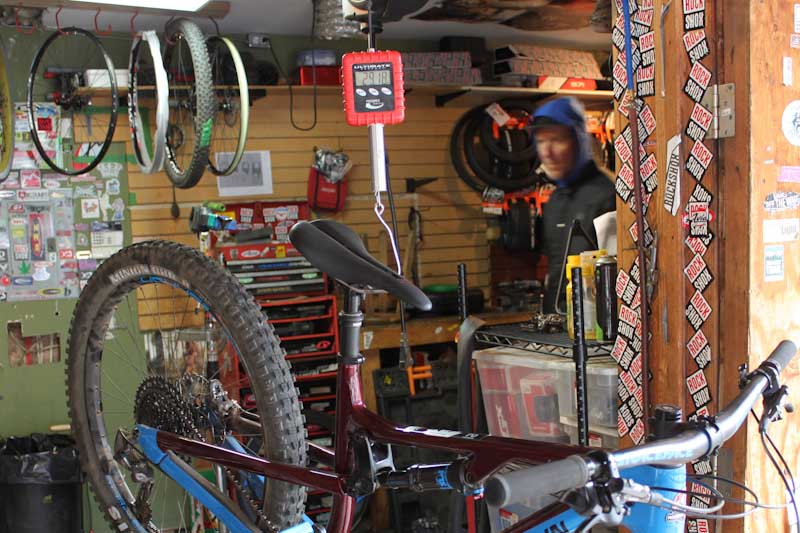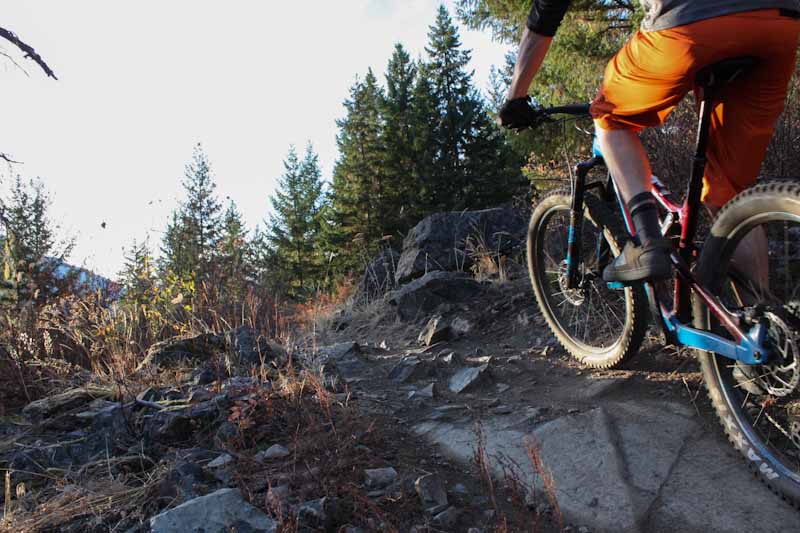This summer, I learned how capable the combination of a lightweight carbon frame, 140mm of travel and 27.5+ wheels can be! I got a chance to test Rocky Mountain’s 2018 Pipeline Carbon 70, and was delighted to discover it’s a highly versatile and very fun bike that encouraged me to push my limits on both the ups and downs.
Aboard the Pipeline I found myself suddenly enjoying the tougher sections of climb trails, and on the descents I was pushing corners and creeping down rock slabs with a new level of confidence. The plus sized tires on the Pipeline’s lightweight frame makes this bike feel like a rally car with monster truck wheels.
This was my first experience on plus-sized wheels, and I was immediately impressed with the traction but also surprised how much the tires help absorb impacts. Even compared to the last bike I rode with 2.5” tires on 29mm wide rims, the 2.8” treads on 35mm rims made such a difference that the 140mm Pipeline felt almost as plush as my 160mm bike.
The big tires also carry momentum well, and I felt like I was climbing faster than ever on the Pipeline. My local trails saw an arid summer, but no matter how steep and loose it seemed I could clamber up anything without spinning a tire. Descending traction was equally inspiring, particularly in the corners where the extra width lets you lean over just a bit further. Also, if you like inching down rock slabs you’ll love the extra grip the plus tires provide.
The top-of-the-line 2018 Pipeline 70 features a full carbon front and rear triangle. This frame borrows a design cue first seen on Rocky Mountain’s Maiden DH bike; the Pipeline’s pivot at the chainstay/seatstay is hidden from view, and only accessible from the inside. While the frame looks slim overall, the head tube junction and chainstay yoke are noticeably beefy.
I really enjoyed Rocky Mountain’s four-bar Smoothlink suspension. I loved how supple yet poppy this bike felt when descending, but it does rely on its multi-position shock for efficient climbing. Pedalling the Pipeline with the shock wide open, I could see the bike bouncing with every stroke. Thankfully modern shocks have different modes to compensate.
The frame’s rear end offers plenty of clearance for the stock 2.8” tires. Cables are internally routed through the downtube but run externally on the rear triangle. The Pipeline uses a press fit BB, a Boost 12x148mm rear axle (and 110mm front), and there’s one bottle cage mount on the inside of the downtube. I really like Rocky Mountain’s integrated Spirit Guide. It’s a sleek and simple unit that bolts directly to the chainstay, and it did its job- I never dropped a chain.
The Pipeline provides what I’ll call a ‘classic modern’ fit and feel. I ride medium-sized frames, and this one felt comfortable right away. Its lengthy 601mm front end, 435mm chainstays and steep 74.6 degree seat angle combine to center your body nicely between the wheels. The best part is, Rocky Mountain’s Ride 9 chip allows you to fine-tune the geometry and shock rate. The figures above are based on the neutral position (5), but the Pipeline gives you nine positions to play with.
Across all nine positions the head and seat tube angles only change by one degree, but the BB drop ranges from 20-33mm, and the reach moves from 427-438mm (medium frame). I started out with the bike in the neutral setting (5) then tried a few slacker positions. In any setting I was in a good position for mashing pedals, and it wasn’t hard to lean over the front wheel while tackling steep bursts. The BB has a 27-33mm drop between settings 1 and 5, and the Pipeline rides very low on the trail- I’ve struck my pedals quite a few times on this bike.
So why have nine positions with such minor geometry increments? Because the Ride 9 adjustment has a significant impact on the shock’s rate. Moving the chip is less about changing the frame’s geo than it is about adjusting the rear suspension’s character. More on that in a minute…
The Pipeline’s Fox Float DPS EVOL Performance Elite rear shock has three settings, plus an open-mode adjustment. I found the Firm mode very stiff, and it’s quite clunky when it takes a hit. For climbing singletrack I preferred the Medium setting. It strikes a nice balance between pedalling efficiently and keeping your rear wheel glued.
Open mode is soft and cushy, and in the Pipeline’s neutral geo setting (5) it offers a linear curve that encourages the shock to dive deep. The ride is super supple, but I never went any further in that direction as I was bottoming out quite easily on descents. When I jumped to the slackest/most progressive setting (1) the shock ramped up much earlier and I couldn’t get full compression, so I found setting 3 was the right balance for me. As for the open-mode adjustment, I started in the softest position (1) and didn’t feel much difference in the 2nd setting but after clicking to the 3rd I noticed a bit more bottom-out resistance.
While I usually ride beefier forks the Fox 34 Float Performance Elite fork was certainly stiff enough for me. The fork’s action is very smooth, and they handled rocky trails without a whimper. As for the fork’s settings, Firm mode is very stiff and I only used it to ride across town to the trailhead. Medium is sufficiently soft for handling bumpy trails, but progressive enough to keep you riding high in the travel. In Open mode the fork becomes highly active and more linear, gobbling up big bumps with every millimeter available.
The Pipeline 70 comes with a decent component setup, but I feel like a few things could have been upgraded for a bike that retails at $5299 USD. The Raceface Turbine R handlebar is a good width at 780mm, but a carbon bar would have been a nice touch. SRAM’s GX Eagle drivetrain offers solid performance with smooth action and a tangible click at the shifter, but I’d be happier to find an XO1 derailleur out back.
Shimano’s XT brakes were solid as usual; they require minimal squeezing effort, and they’re not too grabby. The Stan’s Baron S1 rims are running true with no dents or dings. I’ve had no issues with Fox’s Transfer dropper post, and I like the compact under-bar lever. Last but not least, the WTB Silverado saddle is familiar and friendly with my behind. All these parts on the Pipeline’s carbon frame adds up to a complete bike weight of just 29.2lbs.
To sum things up, I thoroughly enjoyed riding the Pipeline. You definitely have to watch your pedals on this lowrider, but that issue aside I’ve never ridden a bike that is so confidence inspiring on both the climbs and descents. On my first ride, I burned out on a familiar ascent because I was so excited about how fast I felt I forgot to pace myself! Pointing down, the bike’s light weight and lively character put a smile on my face every time, and then there’s those wheels…
This bike may have converted me to plus tires! On a light enough complete build like this one, there is little penalty to pay for going wider and the handling advantages were blatantly obvious. Blowing through the roughest stuff I could find was just a treat, not to mention (again) that slashing corners, crawling slabs and riding dusty chutes was suddenly child’s play.
The 2018 Pipeline turned my recent rides into a game of finding my new limits. Feeling that good in the saddle gives you confidence, inspires you to ride harder and most importantly is a whole lot of fun!
